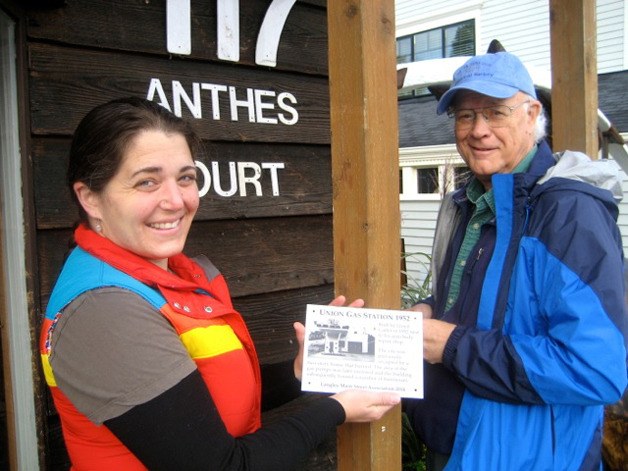The story of Langley’s early days is now a bit more visible thanks to the recent installation of informative plaques on historic downtown buildings.
Last month, Langley Main Street Association hung the first six of at least 20 stainless steel plaques on select structures along Anthes Avenue, First and Second streets. Each has an image and a short description of the building’s past.
“Every older building tells us something about the previous history of the town,” said Bob Waterman, a Main Street board member and historian. “They help define the character of the community, and provide a visual record of how the town has changed over time.”
One of the Main Street Association’s roles is to increase community awareness and appreciation of Langley’s history. The organization hopes that the plaques will help share and preserve the town’s early history.
Waterman has been gathering information and photos of early Langley for years. Along with Frances Wood, Waterman wrote the book on the early history of the city, “Images of America, Langley.” He also presented a series of lectures on the town’s early years and the history of the marina during last year’s Centennial Celebration, and serves on the South Whidbey Historical Society board.
According to Waterman, older buildings serve as containers for the stories of the people who built and occupied them over the decades.
“When an older building is lost, we lose a bit of our history and it becomes easier to forget those who came before,” he said.
The first six plaques were installed at: The Whale Center on Second and Anthes, which was built in 1952 by Lloyd Carter as a Union Gas Station; Music for the Eyes, located on First Street and built in 1905 by Roderick McLeod for his family (it was transformed into a grocery store in 1941 and went through several changes over the years); The Moonraker building, which was the town’s first post office and built in 1915 by Frank E. Furman, Langley’s first mayor; the original Star Store, built by Joseph Primavera and opened in 1922 (it was named for a brand of shoes); the building that houses The Langley Café; Brackenwood Gallery; Chocolate Flower Farm; and the Langley Public Library.
Some building owners paid the cost or part of the cost of the plaques while the rest was paid for by Main Street Association.
“We are very grateful to the building owners who granted permission for a plaque to be placed on their building and helped in their design,” Waterman said. “Hopefully additional property owners will become involved in the future.”
Five more plaques are in production to be placed by early 2015 and several more are planned. For more information contact langleymainstreet@whidbey.com.



